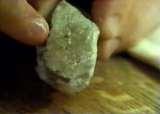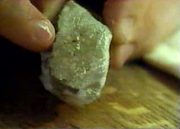
Shocked quartz
Encyclopedia
Shocked quartz is a form of quartz
that has a microscopic structure that is different from normal quartz. Under intense pressure (but limited temperature), the crystalline structure of quartz will be deformed along planes inside the crystal. These planes, which show up as lines under a microscope, are called planar deformation features
(PDFs), or shock lamellae.

testing, which caused the intense pressures required to form shocked quartz. Eugene Shoemaker showed that shocked quartz is also found inside craters
created by meteor
impact, such as the Barringer Crater and Chicxulub crater
. The presence of shocked quartz proves that these craters were formed by an impact: a volcano
would not generate the pressure required.
at the boundary between Cretaceous
and Tertiary
rocks. This is further evidence (in addition to iridium
enrichment) that the transition between the two geological periods was caused by a large impact. Though shocked quartz is only recently recognized, Eugene Shoemaker discovered it in building stones in the Bavaria
n town of Nördlingen
.
of silicon dioxide
: coesite
and stishovite
. These polymorphs have a different crystal structure than standard quartz. Again, this structure can only be formed by intense pressure, but moderate temperatures. High temperatures would anneal the quartz back to its standard form. Coesite and stishovite are also indicative of impact (or nuclear explosion
).
Quartz
Quartz is the second-most-abundant mineral in the Earth's continental crust, after feldspar. It is made up of a continuous framework of SiO4 silicon–oxygen tetrahedra, with each oxygen being shared between two tetrahedra, giving an overall formula SiO2. There are many different varieties of quartz,...
that has a microscopic structure that is different from normal quartz. Under intense pressure (but limited temperature), the crystalline structure of quartz will be deformed along planes inside the crystal. These planes, which show up as lines under a microscope, are called planar deformation features
Planar deformation features
Planar deformation features, or PDFs, are optically recognizable microscopic features in grains of silicate minerals , consisting of very narrow planes of glassy material arranged in parallel sets that have distinct orientations with respect to the grain's crystal structure.PDFs are only produced...
(PDFs), or shock lamellae.

Discovery
Shocked quartz was discovered after underground nuclear bombNuclear weapon
A nuclear weapon is an explosive device that derives its destructive force from nuclear reactions, either fission or a combination of fission and fusion. Both reactions release vast quantities of energy from relatively small amounts of matter. The first fission bomb test released the same amount...
testing, which caused the intense pressures required to form shocked quartz. Eugene Shoemaker showed that shocked quartz is also found inside craters
Impact crater
In the broadest sense, the term impact crater can be applied to any depression, natural or manmade, resulting from the high velocity impact of a projectile with a larger body...
created by meteor
Meteoroid
A meteoroid is a sand- to boulder-sized particle of debris in the Solar System. The visible path of a meteoroid that enters Earth's atmosphere is called a meteor, or colloquially a shooting star or falling star. If a meteoroid reaches the ground and survives impact, then it is called a meteorite...
impact, such as the Barringer Crater and Chicxulub crater
Chicxulub Crater
The Chicxulub crater is an ancient impact crater buried underneath the Yucatán Peninsula in Mexico. Its center is located near the town of Chicxulub, after which the crater is named...
. The presence of shocked quartz proves that these craters were formed by an impact: a volcano
Volcano
2. Bedrock3. Conduit 4. Base5. Sill6. Dike7. Layers of ash emitted by the volcano8. Flank| 9. Layers of lava emitted by the volcano10. Throat11. Parasitic cone12. Lava flow13. Vent14. Crater15...
would not generate the pressure required.
Prevalence
Shocked quartz is found worldwide, in a thin K–T boundaryK–T boundary
The K–T boundary is a geological signature, usually a thin band, dated to 65.5 ± 0.3 Ma ago. K is the traditional abbreviation for the Cretaceous period, and T is the abbreviation for the Tertiary period...
at the boundary between Cretaceous
Cretaceous
The Cretaceous , derived from the Latin "creta" , usually abbreviated K for its German translation Kreide , is a geologic period and system from circa to million years ago. In the geologic timescale, the Cretaceous follows the Jurassic period and is followed by the Paleogene period of the...
and Tertiary
Tertiary
The Tertiary is a deprecated term for a geologic period 65 million to 2.6 million years ago. The Tertiary covered the time span between the superseded Secondary period and the Quaternary...
rocks. This is further evidence (in addition to iridium
Iridium
Iridium is the chemical element with atomic number 77, and is represented by the symbol Ir. A very hard, brittle, silvery-white transition metal of the platinum family, iridium is the second-densest element and is the most corrosion-resistant metal, even at temperatures as high as 2000 °C...
enrichment) that the transition between the two geological periods was caused by a large impact. Though shocked quartz is only recently recognized, Eugene Shoemaker discovered it in building stones in the Bavaria
Bavaria
Bavaria, formally the Free State of Bavaria is a state of Germany, located in the southeast of Germany. With an area of , it is the largest state by area, forming almost 20% of the total land area of Germany...
n town of Nördlingen
Nördlingen
Nördlingen is a town in the Donau-Ries district, in Bavaria, Germany, with a population of 20,000. It is located in the middle of a complex meteorite crater, called the Nördlinger Ries. The town was also the place of two battles during the Thirty Years' War...
.
Structure
Shocked quartz is associated with two high pressure polymorphsPolymorphism (materials science)
Polymorphism in materials science is the ability of a solid material to exist in more than one form or crystal structure. Polymorphism can potentially be found in any crystalline material including polymers, minerals, and metals, and is related to allotropy, which refers to chemical elements...
of silicon dioxide
Silicon dioxide
The chemical compound silicon dioxide, also known as silica , is an oxide of silicon with the chemical formula '. It has been known for its hardness since antiquity...
: coesite
Coesite
Coesite[p] is a form of silicon dioxide SiO2 that is formed when very high pressure , and moderately high temperature , are applied to quartz. Coesite was first synthesized by Loring Coes, Jr., a chemist at the Norton Company, in 1953. In 1960, coesite was found by Edward C. T...
and stishovite
Stishovite
Stishovite is an extremely hard, dense tetragonal form of silicon dioxide. It was long considered the hardest known oxide; however, boron suboxide has recently been discovered to be much harder...
. These polymorphs have a different crystal structure than standard quartz. Again, this structure can only be formed by intense pressure, but moderate temperatures. High temperatures would anneal the quartz back to its standard form. Coesite and stishovite are also indicative of impact (or nuclear explosion
Nuclear explosion
A nuclear explosion occurs as a result of the rapid release of energy from an intentionally high-speed nuclear reaction. The driving reaction may be nuclear fission, nuclear fusion or a multistage cascading combination of the two, though to date all fusion based weapons have used a fission device...
).
See also
- BrecciaBrecciaBreccia is a rock composed of broken fragments of minerals or rock cemented together by a fine-grained matrix, that can be either similar to or different from the composition of the fragments....
- LechatelieriteLechatelieriteLechatelierite is silica glass, amorphous SiO2. One common way in which lechatelierite forms naturally is by very high temperature melting of quartz sand during a lightning strike...
- Shatter coneShatter coneShatter cones are rare geological features that are only known to form in the bedrock beneath meteorite impact craters or underground nuclear explosions...
- Shock metamorphismShock metamorphismShock metamorphism or impact metamorphism describes the effects of shock-wave related deformation and heating during impact events. The formation of similar features during explosive volcanism is generally discounted due to the lack of metamorphic effects unequivocally associated with explosions...

